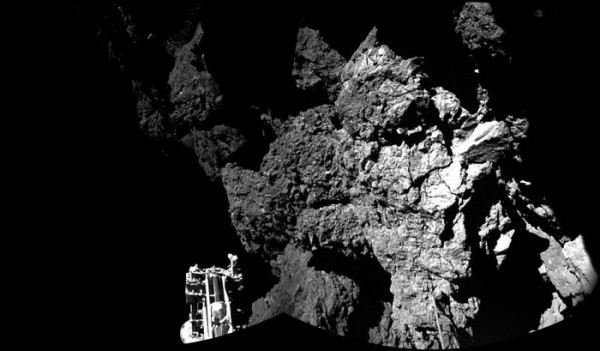By Ana Verayo, | January 10, 2016

Rosetta’s lander Philae is safely on the surface of Comet 67P/Churyumov-Gerasimenko, as these first two CIVA images confirm. One of the lander’s three feet can be seen in the foreground.
Time is running out for the robot lander known as Philae that has been lost on a comet as mission control scientists will now attempt to engage the lander with a communications pass, hoping that the probe would be in a better position to make contact.
Like Us on Facebook
The Philae lander was deployed by the European Space Agency's Rosetta spacecraft that is still currently in orbit of comet 67P/Churyumov-Gerasimenko and landed on the comet last November 12, 2014. However, the lander experienced a bumpy landing, bouncing several times on the surface where it ended up under a dark shadow of a cliff.
Philae obtained some crucial data until its batteries ran out, as the lander needs sunlight to power its solar panels. The lander offered a glimmer of hope last July 9 when the comet made contact but mission control crew lost the signal again as the comet made its closest approach to the sun in August.
Now, comet 67/P is now 186 million miles away from the sun by the end of this month where surface temperatures will dip to minus 58 degrees Fahrenheit or minus 50 degrees Celsius which will become too cold for Philae's systems to start up, according to the ESA.
According to Philae landing manager, Stephan Ulamec, time is running out, which is posted on the agency's website.
Now, the control teams will make its last and final effort on Sunday to contact Philae where they will send out commands to move is flywheel, which is a device that is used to stabilize spacecraft during its descent on the surface of the comet. This can hopefully shift Philae's position where the spinning action of the wheel could shake off the dust from its solar panels, to gain better alignment towards the sun.
This is a long shot, as the team still do not know if Philae's receiver and transmitter are still in working condition as the probe will also be heavily covered with dust. According to operations manager, Cinzia Fantinati, there is a small chance, as we do not want any small stone unturned.
To date, the mothership Rosetta has been orbiting the comet since August 2014, where the mission will last until September 2016.
-
Use of Coronavirus Pandemic Drones Raises Privacy Concerns: Drones Spread Fear, Local Officials Say

-
Coronavirus Hampers The Delivery Of Lockheed Martin F-35 Stealth Fighters For 2020

-
Instagram Speeds Up Plans to Add Account Memorialization Feature Due to COVID-19 Deaths

-
NASA: Perseverance Plans to Bring 'Mars Rock' to Earth in 2031

-
600 Dead And 3,000 In The Hospital as Iranians Believed Drinking High-Concentrations of Alcohol Can Cure The Coronavirus

-
600 Dead And 3,000 In The Hospital as Iranians Believed Drinking High-Concentrations of Alcohol Can Cure The Coronavirus

-
COVID-19: Doctors, Nurses Use Virtual Reality to Learn New Skills in Treating Coronavirus Patients








